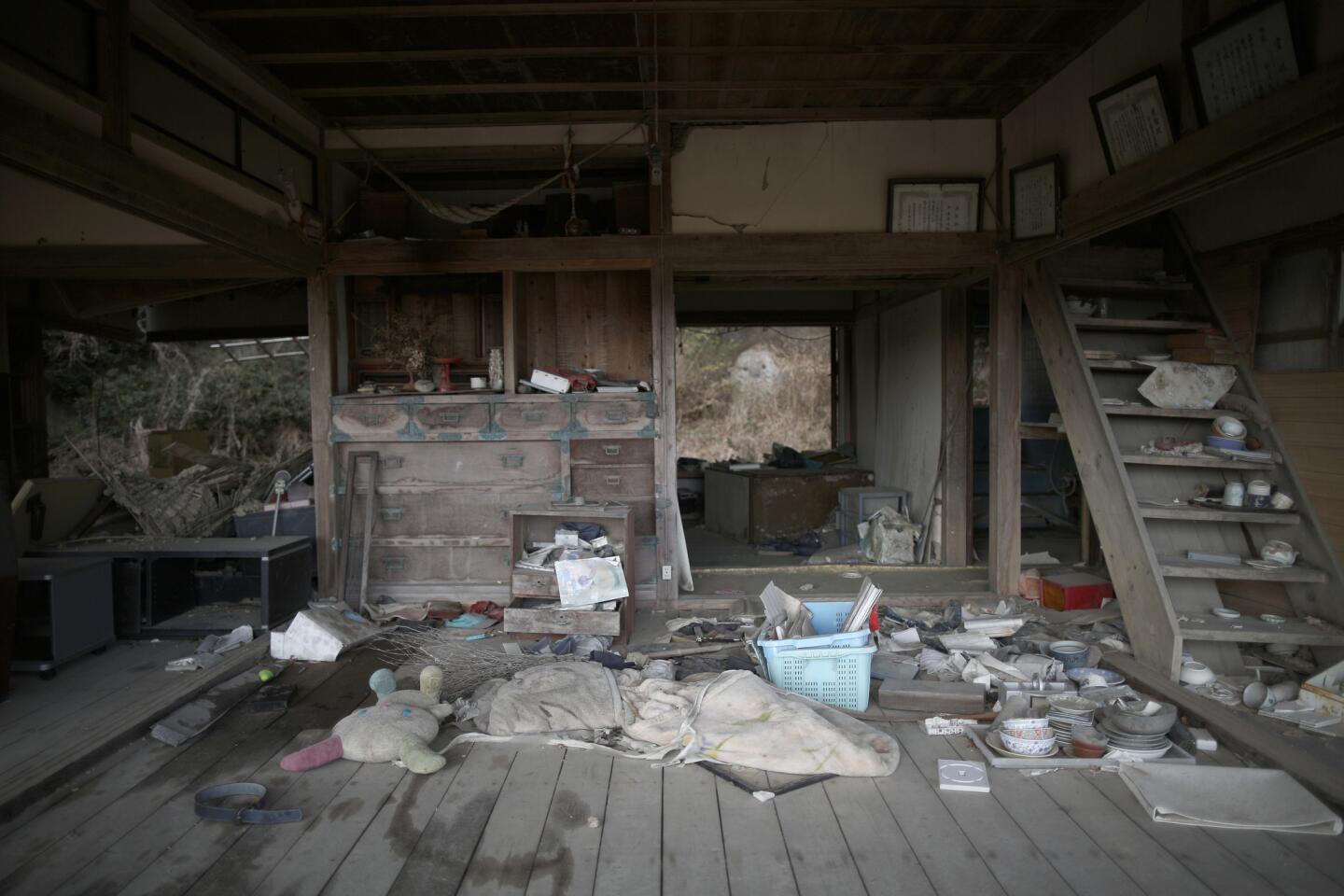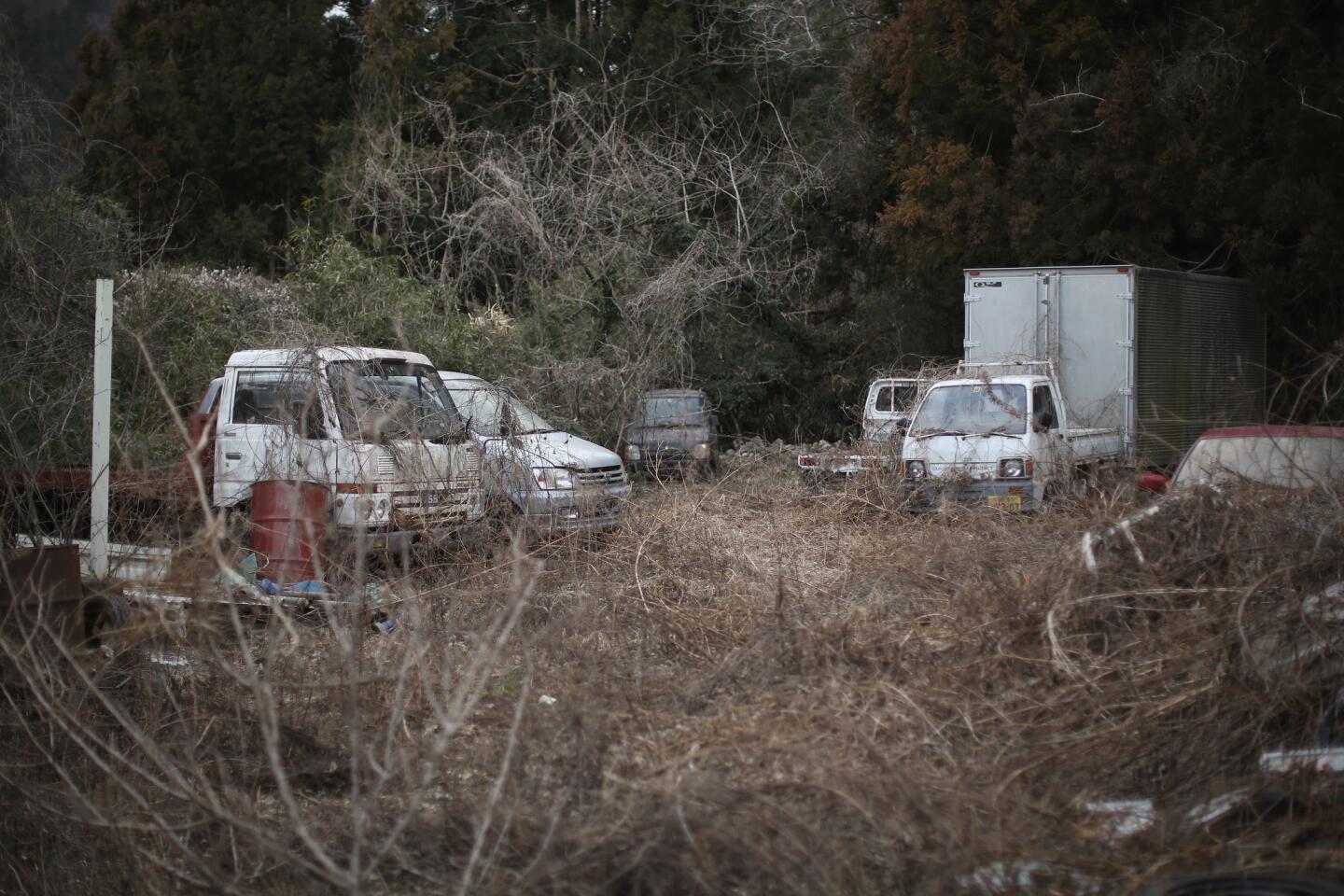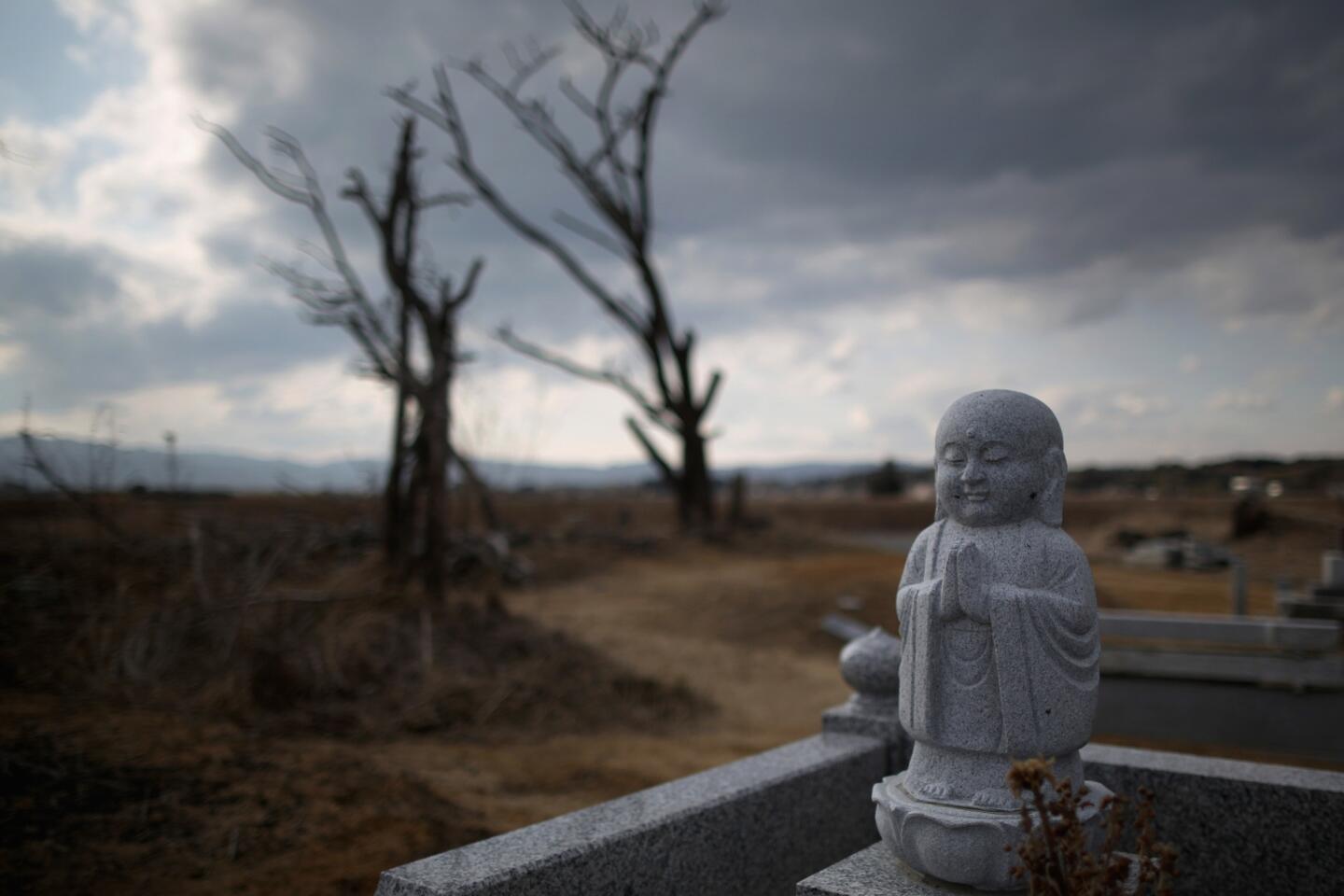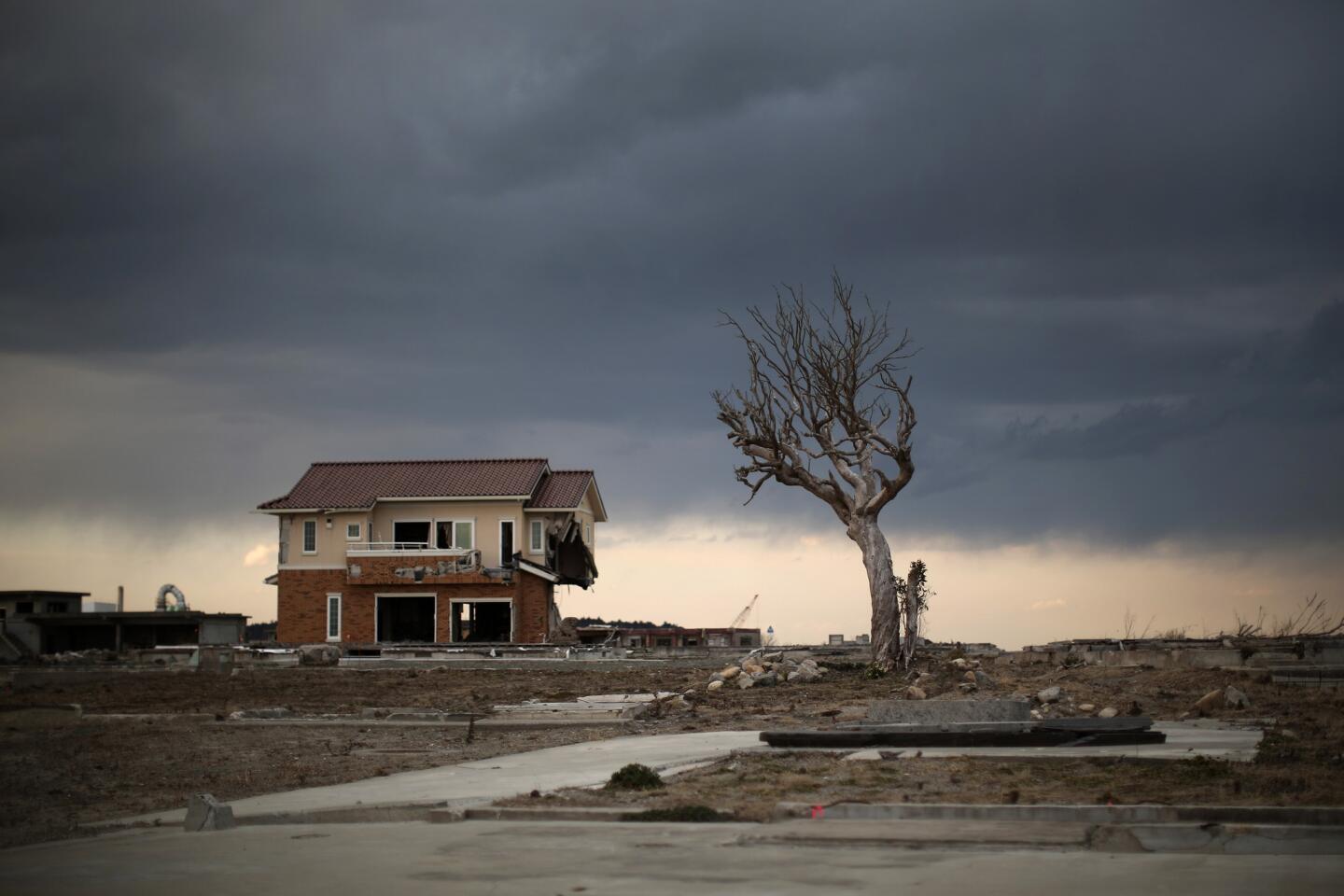At Japan’s Fukushima nuclear complex, robots aiding the cleanup after 2011 disaster

Yusuke Nakagawa of Tokyo Electric Power Co. works in the team that operates the robots used to decontaminate the reactor buildings.
- Share via
Reporting from Tokyo — Hiroshi Endo spent a decade building a robotic arm that Japan deployed to the International Space Station in 2010. But his next challenge made that one look easy.
In 2011, Endo, a 61-year-old retired engineer at Hitachi, the Tokyo-based mega-corporation, began designing a robot to aid in decommissioning the Fukushima Daiichi nuclear plant, the site of a meltdown that marked the worst nuclear crisis since Ukraine’s Chernobyl disaster in 1986.
In space, “you’ve got the sun, the moon, the Earth, temperatures. These are very definite, very specific — they’re not going to change,” Endo said. “But nuclear [reactors] are man-made. What’s going on inside the reactor is totally unknown, after the disaster. The operational environment is very different than space — it’s much harder.”
NEWSLETTER: Get the day’s top headlines from Times Editor Davan Maharaj >>
Over the last five years, since an earthquake, tsunami and nuclear meltdown devastated a swath of Japan’s east coast, killing more than 15,000 people and displacing more than 230,000, the country has embarked on one of the most extensive recovery programs in history.
Robots have played a crucial role in Japan’s efforts to inspect, decontaminate and ultimately decommission the devastated nuclear reactors — a necessary step to regaining public trust and consigning the accident to history.
Experts say that more than 100 types of robots are active at Fukushima, including scores of modifications on a handful of basic designs. They’ve been likened to scorpions, snakes, giraffes and amphibians. They fly, walk, crawl and make underwater maneuvers, braving dust, debris and doses of radiation that could kill a human being. Their variety underscores the size — and complexity — of their task.
“The personnel exposure [to radiation] would be much higher without robots, and off-site releases would be much higher,” said Lake Barrett, an American nuclear energy expert who has consulted for top Japanese officials on the decommissioning program.
There are two types of robots, he said: “diagnostic robots,” which inspect the interiors of the buildings and reactors, and “working robots,” which do physical labor such as clearing debris and removing fuel rods.
“They have [robots] that shoot dry ice” to absorb radiation, he said. “Some shoot high-pressure water … some have carbide teeth that chip away at concrete surfaces, which are the most contaminated part, and suck the chips up in a vacuum cleaner.”
The decommissioning program is funded by the Japanese government and overseen by the International Research Institute for Nuclear Decommissioning, a Tokyo-based coordinating agency. The robots are built by scores of companies: Toshiba, Hitachi, Mitsubishi, BMW and the U.S.-based firm iRobot, best-known for developing the Roomba automated vacuum cleaner.
Much as the U.S. space program developed products that came to be used in everyday life, Barrett said that much of the technology developed to investigate the plants could be “spun off into regular society” — tiny cameras, tiny drones, virtual reality, technology that can transmit data through thick concrete walls.
Yet several engineers said that despite the difficulty of their work, widespread anger over the disaster has cast a pall over their public profile.
“One of the things that’s most interesting, that’s not really understood by the public, is the synergism between engineering technologies and social, political and psychological constraints,” Barrett said. “Engineers can do wonderful things with robots, etc. — and they do — but when it comes time to ask, how do we talk to people about this? How do we explain what the risks are? That’s a big challenge.”
The plant’s operator — the Tokyo Electric Power Co., also known as Tepco — has declared the situation at the plant stable. Thousands of employees still work there, pumping water into the devastated reactors to cool them and storing the contaminated water in massive tanks.
Yet areas in the “exclusion zone” surrounding the reactors remain abandoned and are decaying, their overgrown roads and railways roamed by packs of feral boars. Many former Fukushima residents, even those outside the zone, still refuse to return to their homes; they blame Tepco for neglecting safety standards while designing the plants, and failing to contain the damage from the meltdowns. They consider the disaster man-made.
Tepco’s road map for decommissioning the plants will take 40 years and cost $15 billion.
“Space business is always affirmative — It’s always glorious,” said Endo, the Hitachi engineer. “But with nuclear work, we’re starting at the very bottom.... Those who are working in decontamination are working really hard. However, their public image is really bad, and that’s frustrating. People just don’t want to hear that this is going to take 50 years.”
Fukushima has six reactors, half of which — Units 1-3 — melted down in the disaster. Hitachi is developing inspection robots for Unit 1, and Toshiba robots for Unit 2 — both strewn with extremely hazardous nuclear fuel. In April, Hitachi deployed two slithering “snake robots” to explore the Unit 1 reactor, the worst hit in the disaster. One got stuck and failed; neither spotted melted fuel debris.
Terai Fujio, a chief research scientist at Toshiba, the Tokyo-based multinational corporation, said that his team has been developing a 10-inch-long robot equipped with cameras, sensors and a jointed, scorpion-like tail to investigate the pressure containment vessel surrounding the Unit 2 reactor core.
Toshiba planned to deploy its scorpion robot in early August — to pilot it along a 22-foot-long passageway originally intended to deliver fuel rods to the reactor core. But the mission was stymied by rows of concrete slabs blocking the robot’s path.
Although workers managed to mechanically remove the blocks in October, they soon discovered another problem. Toshiba intended the robot to enter the vessel via a “penetration pipe,” yet radiation levels near the vessel were too high to safely install it. (Tepco is currently decontaminating the area and hopes to deploy the robot this year.)
Data collected by the robot, engineers say, will eventually help them design a second robot to remove the molten fuel, a task that’s never been attempted.
Toshiba has also developed an “amphibious robot” to remove fuel rods from the rubble of Fukushima’s Unit 3, which the firm built decades ago.
The robot is actually two massive, remote-controlled rigs, both more than two stories high and wider than a school bus. They were developed with help from Toshiba’s U.S.-based subsidiary Westinghouse and will be shipped to Fukushima by boat and placed on top of the unit’s roof, which was destroyed by a hydrogen explosion in 2011.
The rigs are outfitted with dangling mechanical arms that clear debris from the building, then remove the fuel rods from a pool at the bottom of the reactor (hence the amphibious designation) and place them into a radiation-proof cask.
Sekiguchi Koichi, a Toshiba developer, said that 60 to 70 people are working on the project. “Last February to December, we actually trained here,” he said in an interview at a cavernous Toshiba factory in Tokyo. He gestured at the two hulking rigs and a pit between them, deep and packed with scaffolding. “There was water in there, with simulated fuel rods inside. We trained getting the fuel and dismantling debris.”
Koichi said that they’ve been training for every contingency — but that they’re prepared to fail, over and over, before they get it right.
“Of course the pressure is enormous,” he said. “We are manufacturing a robot that’s going into an environment that is completely unknown to us. We have done risk assessments, but things happen that defy expectations. So how do we counter that?
“Computers just freeze up from time to time — and so do robots,” he added. “There’s no 100% guarantee of anything.”
ALSO
Iran’s latest missile test launches do not violate nuclear deal, U.S. says
Spiritual guru’s festival in India to go ahead despite environmental concerns
U.S. and Canada pledge to cut methane emissions as part of broad climate change agreement
More to Read
Sign up for Essential California
The most important California stories and recommendations in your inbox every morning.
You may occasionally receive promotional content from the Los Angeles Times.

















